Happy New Year everybody!
The arrival of this particular year, 2022, made me think back several decades, though. As a teenager, growing up in Hamburg, Germany, I became fond of Science Fiction films in the late 1970s, and one I remember especially well from a series of SF movies on late-night TV was one from 1973 that in the German dubbed version was called “… Jahr 2022 … die überleben wollen …” (literally ‘… year 2022 … those who want to survive …’). Here’s a photo of a movie poster from the time (obtained from this source – external link):
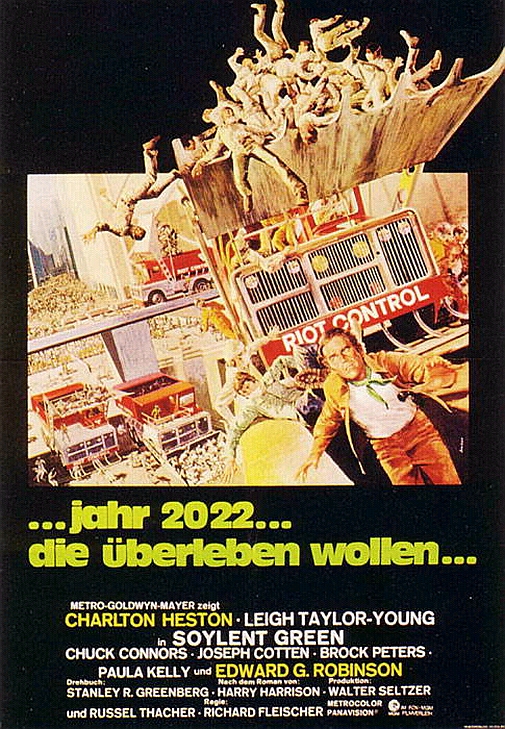
The title of the American original is “Soylent Green”. If you don’t know it you can find a more detailed summary here (external link). Here’s just the most central gist: It’s basically a crime story woven into a projected future blighted by overpopulation, pollution, resource depletion and extreme inequality, a world in which a tiny super-rich elite retains access to good but extremely expensive food and lives a life of luxury in highly fortified gated compounds, while the general population in a New York with 40 million inhabitants, languishes in a sweltering, dirty dystopia in which all food is produced and supplied by a single giant corporation, Soylent. Dished out are basically processed wafers, Soylent Red and Soylent Yellow. When supplies run low, regular riots break out that are crushed, literally, by “scoops” with giant shovels. Especially in demand is a recently introduced third type of food, Soylent Green, allegedly made from the oceans’ plankton. But the plot of the film is ultimately the grim discovery that the oceans are already dead and Soylent Green is instead made from human bodies. The famous final line in the film, with its seriously wounded desperate main character shouting to the world “Soylent Green is people!”, is one in the 100 top quotes from a century of American films on a list released by the American Film Institute (external link) … in German that line was even more explicit “Soylent Grün ist Menschenfleisch!” (i.e. ‘human flesh’ or ‘human meat’).
I remember how back then in 1978 after having watched that film, I was trying to project myself into such a future, calculated how old I would be in 2022 and tried to imagine … but as a teenager you simply cannot picture yourself in your 50s, you just can’t.
However, the film, arguably the first “eco-dystopian” Sci-Fi thriller of all time, did trigger in me an interest in futurology and environmental issues, just as the film had been partly inspired by the first climate-economy-modelling study in this vein, which was released by the Club of Rome in 1971/2.
It also so happened that shortly after I saw the movie there was a two-part science documentary on TV by Hoimar von Ditfurth called “Der Ast, auf dem wir sitzen” (if you understand German you can watch it here – external link – and within Germany, or via a VPN, find its re-run on the TV station’s media archive here – also external link). The title, which translates as ‘the branch we are sitting on’, is an allusion to the idiom “den Ast absägen, auf dem man sitzt”, literally ‘to saw off the branch one is sitting on’, for which some dictionaries suggest ‘to bite the hand that feeds you’ as an equivalent, though that doesn’t quite capture the picture. Anyway, the programme projected with stunning accuracy the sort of discussions about the tension between ecology and growth economy as well as the various concomitant environmental consequences that we have indeed been seeing in the intervening 44 years.
The “Soylent Green” movie was of course too wildly pessimistic – New York in the actual year 2022 still has under 9 rather than 40 million inhabitants and as far as I know we haven’t begun eating each other yet. But the general drift of the movie’s imagined future, the Club of Rome’s predictions and the actual warnings from climate science today are scarily parallel. Widely ridiculed at the time, the Club of Rome’s general predictions of the consequences of a continued “business as usual” model now stand largely vindicated (see e.g. this 2020 update paper – external link). The dystopia depicted in “Soylent Green” may still lie a few decades away, but it’s not wholly improbable (despite some logical inaccuracies – e.g. how can global warming have progressed so much without New York getting flooded?). Sci-Fi movies often get the timescales wrong. Just think of Stanley Kubrick’s “2001: A Space Odyssey”, which saw us colonizing space, mining the moon and sending missions to Jupiter … 21 years ago! The fact that none of this has actually happened yet as predicted in these fictional movies does not mean it can never happen, though.
But, so you may have been asking yourself, what does all this have to do with dark tourism? Indeed, climate change and all that rarely features in dark tourism (DT), probably because DT is predominantly about dark pasts, not about the future. Moreover, climate change symptoms already in evidence rarely produce visitable concrete tourist sites. But there are a few exceptions, most notably retreating glaciers.
Most glaciers in the world are shrinking due to global warming. And occasionally the shrinkage is marked by signs on tourist walking routes. Here’s an example I spotted in Norway en route to the Briksdalsbreen glacier tongue:
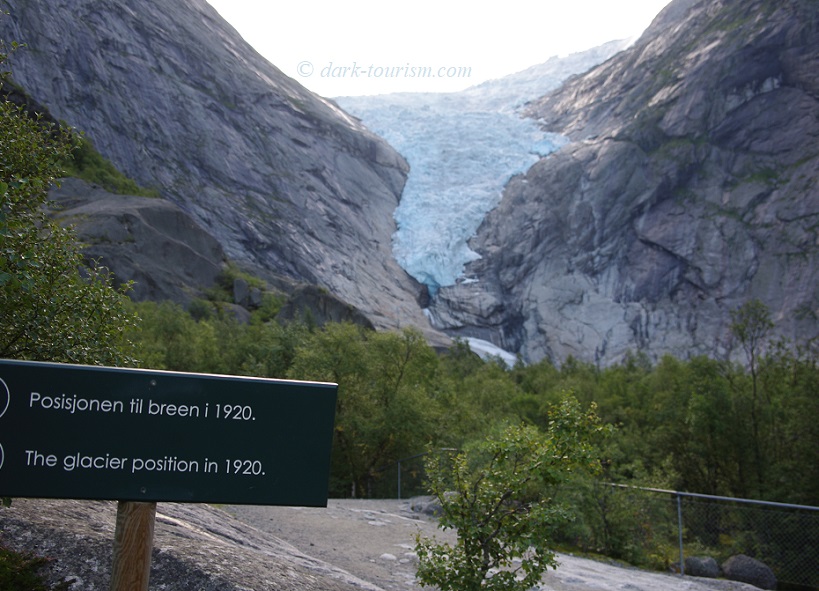
From where the sign stood it was still roughly half a mile to the actual bottom of the glacier so you can get an impression of how much ice must have been lost. This photo was taken in August 2012, so I wonder how much smaller this glacier has become in the intervening almost ten years. The same applies to this glacier tongue:
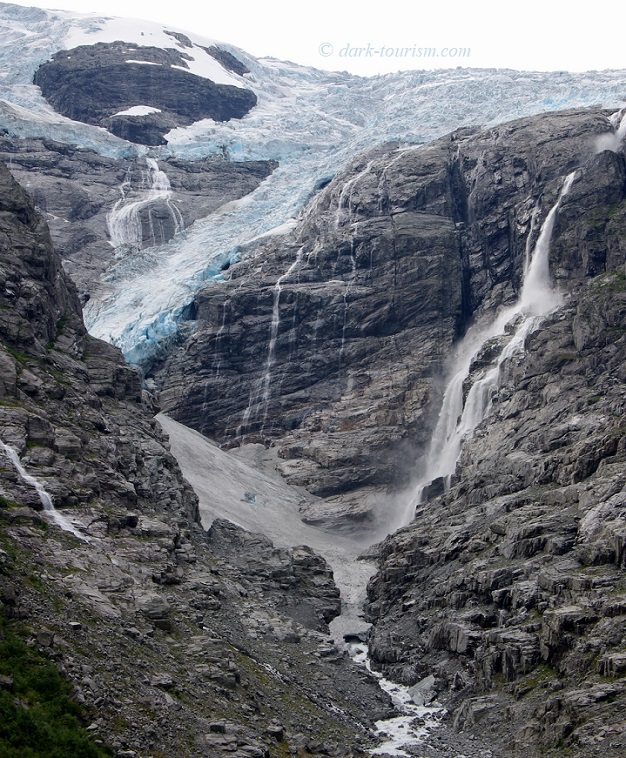
This is another one of the many glacier tongues that come down from the big icy plateau that is Jostedalsbreen, continental Europe’s largest glacier (nearly 200 square miles in area). In this photo you don’t even need any roadside signs to get an impression of the loss of ice. You can see from the rounded rock now exposed that it must once have been covered by ice … compare the ice-smoothed rock to the pointier, rectangular blocks of rock in the bottom right corner!
When I was at this spot with a view of Kjenndalsbreen, I decided to hike up to that big block of ice you can just about make out between those rocks and the glacial meltwater river at the bottom of the glacier. In this next photo, the red dot by the ice block where the photo’s copyright watermark is … that’s me (also gives you a reference point as to the dimensions):
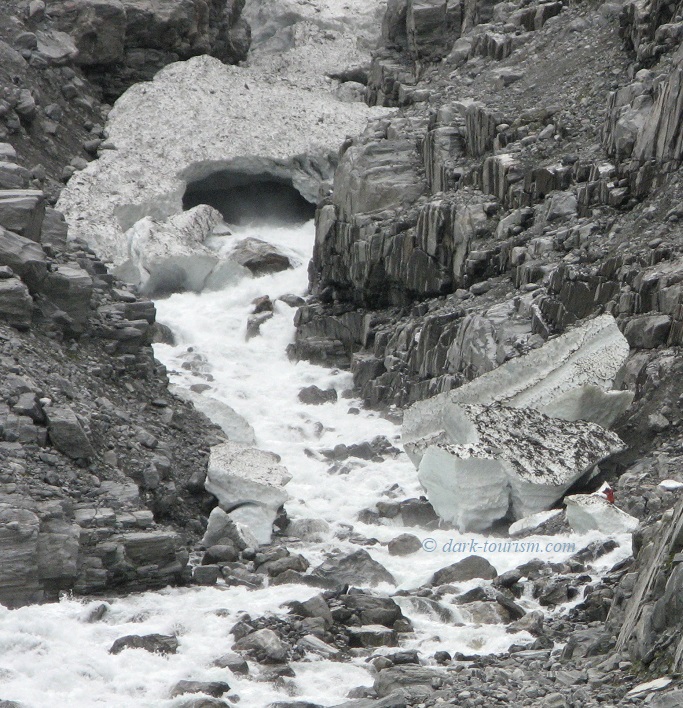
Hiking up there was perhaps a little irresponsible and my wife wasn’t particularly happy with me spontaneously ignoring the sign warning of the risk of sudden rock or icefalls or flash floods. I felt a little adventurous at that moment but would not have attempted to proceed any further than this. Those blocks of ice are presumably gone by now …
Back to climate change: on the other, southern side of Jostedalsbreen near the town of Fjaerland there is a glacier museum, called Norsk Bremuseum in Norwegian, which is about glaciers in general and the Jostedalsbreen system in particular. Its building is of a modern design looking like this:
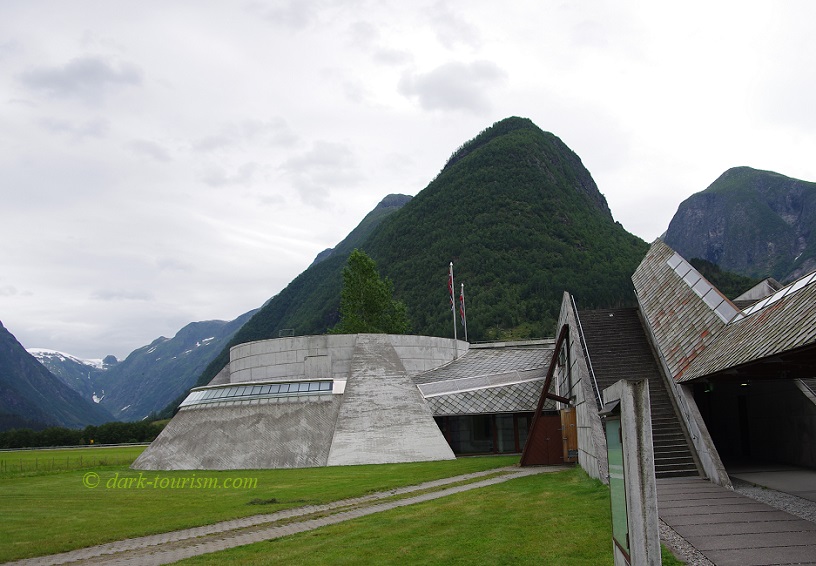
Inside is not only the main exhibition about all things glacial (including a replica “Ötzi”, the mummified body found in the Austrian Ötztal Alps in 1991), but also an extra exhibition about climate – past, current and in the future. It’s of course the latter two where the focus turns directly and explicitly to the current climate crisis and its potentially catastrophic consequences. Amongst the exhibits are these exaggerated Earth globes covered by too much industry and too many people (same as the lead photo at the top of this post):

Towards the end of the exhibition two paths are explored in the projections of what the world might be like in the period 2050 to 2100; the pessimistic one being basically the continued “business as usual” model of unrestrained economic growth and global warming that was one of the predictions of the Club of Rome study from the early 1970s. This would result in an escalating and increasingly existential crisis and eventual collapse. And it’s illustrated in this museum by, amongst other things, imagined media headlines about some of the events that this path could come with, such as mass “climate refugee” movements and the giving up of coastal cities such as New York or Amsterdam due to rising sea levels.

However, the other path explored in the museum is almost endearingly optimistic, with slogans like “we learned and changed our ways”, while the voice of David Attenborough admonishes us that “this [planet] is the only home we have”, but also stating that it is not too late yet to make the required changes to ensure our civilization’s survival.
But so much for Norway and its unique glacier and climate museum that I visited in 2012. Over five years earlier, in May 2007 (shortly before I discovered DT!), I visited Austria’s largest glacier, the Pasterze, which stretches out below the highest mountain in Austria, the Großglockner. Next to the main car park by the viewpoint and restaurant is a funicular going down the mountainside to where the edge of the glacier used to be when the tracks were laid. When I got there, a sign pointed out the path you now had to follow to get to the ice:
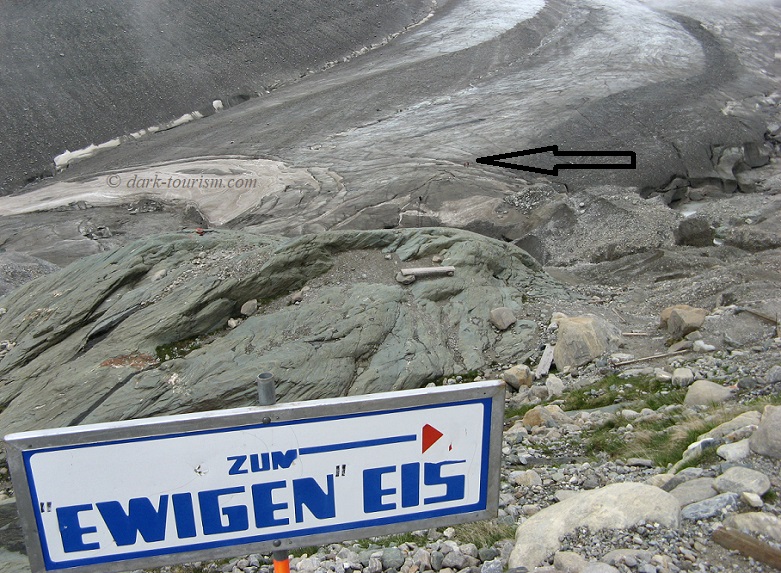
The sign says “zum ewigen Eis”, or ‘to the eternal ice’, except, as you can see, the then edge of the glacier was already a long way away. And as it is evidently no longer “ewig” some jokester put inverted commas around that word on the sign.
Back then it was a ca. 30 minute downhill hike to get to the edge of the ice. The main tip of the glacial tongue was where the copyright watermark is in the photo. To the right of that you can just about make out people on the ice – marked by an arrow. There were steps on the ice edge that allowed access to the glacial ice field.
Almost 15 years on, the ice has retreated further by about a mile (1.7 km) and where the ice was in the photo above is now a greenish meltwater lake – as you can see here on Google Maps (external link).
Climate warming not only affects glaciers in the Alps but also brings changes to the mountains themselves, especially by making formerly perma-frozen rock masses unstable. Near Grindelwald in Switzerland there are hiking trails which at intervals feature information panels about global-warming-induced changes in the Alpine mountainscape. These panels also have QR codes that you can use to download extra background information about all this onto a smartphone or tablet. So this is an example of where state-of-the-art touristification is applied to the issue of climate change!
When I was in this region of Switzerland in the summer of 2020, I didn’t have the time to do this hike myself (but I’d seen a TV documentary about it), however I can give you a photo I took from the train showing the Eiger and Mönch mountains near Grindelwald – with another train of the Jungfrau Railway at the bottom. This photo featured on this blog before – namely in this post.
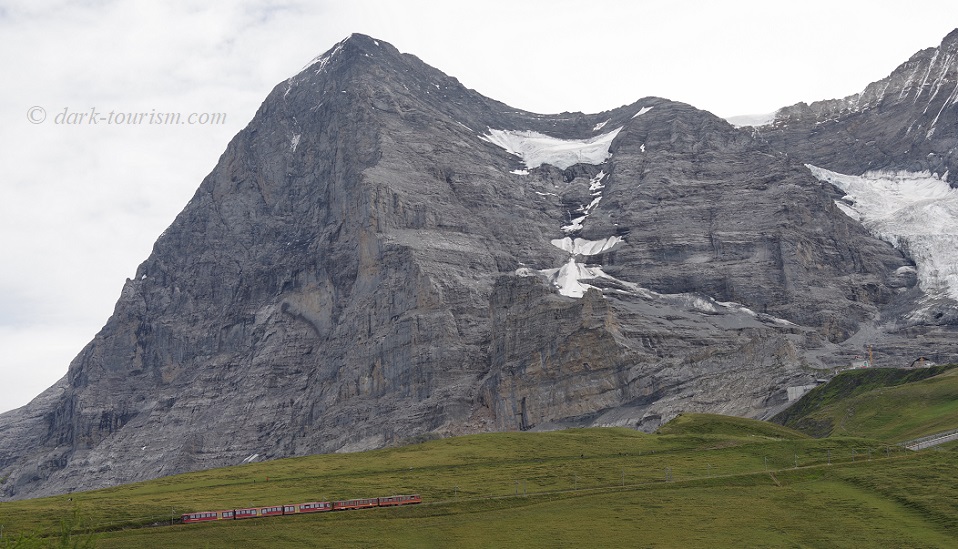
But with this I come to a close. This post covered what is still a rather niche part of dark tourism. But I wonder whether it will become more prevalent as climate change progresses and awareness of it deepens. We will see …

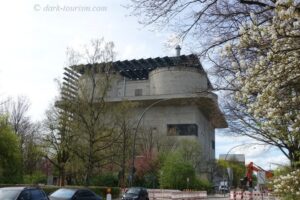
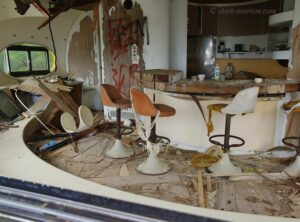
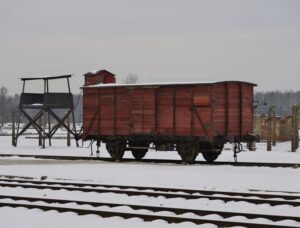
One Response